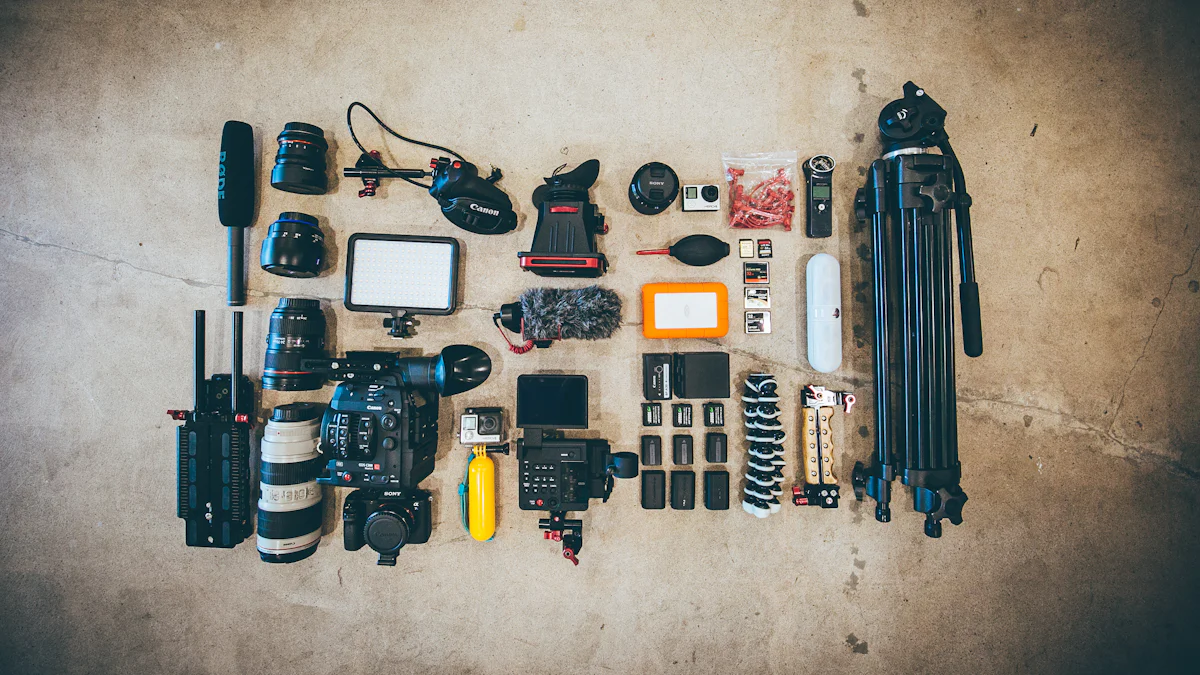Steps to Launch Your Real Estate Photography Business

Real estate photography plays a crucial role in today's market. Top-notch photography helps secure more listings and sells properties faster. Properties with high-quality photos often sell closer to their initial price. Starting a real estate photography business offers numerous benefits. This niche can develop a steady client base, including hotels and brokers. Real estate photography also provides a lucrative opportunity for photographers. Learning how to start a real estate photography business will set you on a path to success.
How to Start a Real Estate Photography Business
Research the Market
Identify your target audience
Identify the specific group of clients who will benefit from your services. Focus on real estate agents, property managers, and homeowners. Understand their needs and preferences. Tailor your services to meet those needs. This approach will help you attract more clients.
Analyze competitors
Study your competitors in the real estate photography market. Look at their pricing, services, and marketing strategies. Identify their strengths and weaknesses. Use this information to differentiate your business. Offer unique value that sets you apart from the competition.
Define Your Niche
Residential vs. commercial properties
Decide whether to focus on residential or commercial properties. Residential properties include homes and apartments. Commercial properties include office buildings and retail spaces. Each type of property requires different photography techniques. Choose the niche that aligns with your skills and interests.
Specializations (e.g., luxury homes, rental properties)
Consider specializing in a specific type of property. Luxury homes require high-end photography techniques. Rental properties may need frequent updates and quick turnaround times. Specializing can help you become an expert in that area. This expertise can attract more clients looking for specialized services.
Create a Business Plan
Outline your services
Clearly define the services you will offer. Include basic photography packages, virtual tours, and drone photography. Provide detailed descriptions of each service. This clarity will help potential clients understand what they can expect.
Set financial goals and budget
Establish clear financial goals for your business. Determine how much revenue you need to generate to cover expenses and make a profit. Create a budget that includes equipment, marketing, and operational costs. Regularly review and adjust your financial plan to stay on track.
Plan for growth and scalability
Think about how your business can grow over time. Plan for adding new services or expanding to new markets. Consider hiring additional photographers as your client base grows. A well-thought-out plan will help you scale your business efficiently.
Legal and Administrative Setup
Register Your Business
Choose a business name
Select a unique and memorable name for your real estate photography business. Ensure the name reflects professionalism and creativity. Verify the availability of the name through a business name search tool. A distinctive name will help your brand stand out in the market.
Register with local authorities
Register your business with local authorities to comply with legal requirements. Obtain a business registration certificate from your city or county office. This step legitimizes your business and builds trust with clients. Registration also helps protect your business name from being used by others.
Obtain Necessary Licenses and Permits
Business licenses
Apply for a business license to operate legally in your area. Contact your local government office to understand the specific requirements. A business license ensures you meet all local regulations. Operating without a license can result in fines and legal issues.
Photography permits
Secure photography permits if you plan to shoot in public or private spaces. Some locations require a property release form to use the images commercially. This document grants permission to photograph on private property. Always check local regulations to avoid legal complications.
Set Up Business Finances
Open a business bank account
Open a dedicated business bank account to manage your finances. Separate personal and business finances to simplify accounting. A business account also enhances your professional image. Clients prefer dealing with businesses that have clear financial practices.
Set up accounting and bookkeeping
Implement an accounting system to track income and expenses. Use bookkeeping software to manage your financial records efficiently. Accurate accounting helps you monitor your business's financial health. Regularly review your finances to ensure profitability and growth.
Acquiring Equipment and Software

Essential Photography Gear
Cameras and lenses
Investing in a quality camera forms the foundation of your real estate photography business. A camera with interchangeable lenses offers versatility. You can start with an affordable model and upgrade as your business grows. A wide-angle lens proves essential for capturing tight spaces and making rooms appear more spacious. This type of lens covers most creative real estate photography needs.
Tripods and lighting equipment
A sturdy tripod stabilizes your camera and prevents motion blur. This stability ensures clear and professional images, especially in low-light conditions. Lighting equipment, such as strobes or flashes, becomes crucial in poorly lit homes. These tools help illuminate spaces evenly, enhancing the overall quality of your photos. A wireless remote camera trigger can also reduce micro-vibrations, resulting in sharper images.
Editing Software
Photo editing software options
Editing software plays a major role in transforming your raw images into polished, professional photos. Adobe Lightroom and Photoshop are popular choices among photographers. These tools offer extensive features for adjusting brightness, contrast, and color balance. Affordable alternatives like GIMP and Luminar provide similar functionalities for those on a tighter budget. Familiarity with editing software will make your photos stand out.
Learning resources for software
Numerous online resources can help you master photo editing software. Websites like Udemy and Coursera offer courses tailored to beginners and advanced users. YouTube channels dedicated to photography provide free tutorials and tips. Investing time in learning these tools will significantly improve your photo quality. High-quality edited photos will attract more clients and set you apart from competitors.
Building Your Brand

Create a Professional Website
Portfolio showcasing your work
A professional website serves as the cornerstone of your brand. Showcase your best work in a well-organized portfolio. Highlight diverse property types to demonstrate versatility. Include high-resolution images that capture the essence of each property. A strong portfolio convinces potential clients of your skills.
Contact information and services offered
Provide clear contact information on your website. Make it easy for clients to reach you via phone, email, or a contact form. List all services offered, such as basic photography packages, virtual tours, and drone photography. Detailed service descriptions help clients understand what you offer. Clear communication builds trust and encourages inquiries.
Develop a Marketing Strategy
Social media presence
Establish a robust social media presence to reach a broader audience. Use platforms like Instagram, Facebook, and LinkedIn to share your work. Post regularly to keep your audience engaged. Use hashtags related to real estate and photography to increase visibility. Social media helps attract new clients and keeps existing ones informed.
Networking with real estate agents
Build relationships with real estate agents to expand your client base. Attend local real estate events and introduce yourself to agents. Offer to take sample photos for their listings. Positive experiences lead to referrals and repeat business. Networking helps you understand market needs and trends.
Establish Your Pricing
Competitive pricing analysis
Analyze the pricing strategies of your competitors. Research what other real estate photographers charge for similar services. Set competitive prices that reflect the quality of your work. Competitive pricing attracts clients while ensuring profitability.
Package deals and discounts
Offer package deals and discounts to attract more clients. Create bundles that include multiple services at a reduced rate. Offer discounts for first-time clients or referrals. Special offers encourage clients to choose your services over competitors.
Michael Yates, Marketing Director at Virtuance, emphasizes, “Without a doubt, professional photography is the most critical element of your listing marketing strategy.” High-quality photos can make or break a sale.
Katie Day Dorr from Move4Free Realty, LLC, praises Bryant Payden’s work: “The photographs he takes of properties for sale show the warmth of the home and are very inviting.”
A client testimonial about Virtuance states, "Thanks to Virtuance, my listing sold $5,000 over asking on the first weekend!"
Building a strong brand involves creating a professional website, developing an effective marketing strategy, and establishing competitive pricing. These steps will set you apart in the real estate photography market.
Client Relations and Business Growth
Managing Client Expectations
Clear communication and contracts
Clear communication builds strong client relationships. Always discuss project details before starting. Explain your services, pricing, and timelines. Use written contracts to outline expectations. Contracts protect both parties and ensure mutual understanding. Clients appreciate transparency and professionalism.
Delivering high-quality work on time
Timely delivery of high-quality work earns client trust. Meet deadlines consistently to build a reliable reputation. Use efficient workflows to manage your time effectively. High-quality photos will impress clients and encourage repeat business. Satisfied clients often refer your services to others.
Seeking Feedback and Testimonials
Importance of client reviews
Client reviews enhance your credibility. Encourage clients to leave reviews after completing a project. Positive feedback attracts new clients. Reviews also provide valuable insights for improving your services. Regularly monitor and respond to client feedback.
Using testimonials for marketing
Use client testimonials in your marketing materials. Display testimonials on your website and social media profiles. Real-life experiences resonate with potential clients. Testimonials build trust and showcase your expertise. Highlighting satisfied clients can boost your business growth.
Expanding Your Services
Offering video tours and drone photography
Expand your services to include video tours and drone photography. Video tours provide a dynamic view of properties. Drone photography offers unique aerial perspectives. These services add value and attract more clients. Diversifying your offerings can set you apart from competitors.
Partnering with other real estate professionals
Form partnerships with real estate professionals. Collaborate with agents, brokers, and property managers. Partnerships can lead to more referrals and projects. Networking helps you stay informed about industry trends. Building a strong professional network supports long-term business growth.
Tom, a former real estate agent, transitioned to photography after experiencing poor quality from local photographers. Tom's decision to take high-quality photos for his listings improved his sales and client satisfaction.
Launching a real estate photography business involves several key steps. Research the market, define your niche, and create a solid business plan. Set up the legal and administrative aspects, acquire essential equipment, and build a strong brand. Manage client relations effectively and seek opportunities for growth.
Take the first step today. Start planning and laying the groundwork for your business. The potential for success in this industry is immense. High-quality real estate photography attracts buyers and helps properties sell faster. This niche offers a lucrative and rewarding career path. Embrace the journey and watch your business thrive.
See Also
Enhancing Service Business Growth Using ChatGPT Strategies
Optimizing Sales Pipeline with Step-by-Step AI Chatbot Assistance
Revealing Intercom's Values for Customer Success Roadmap Creation
Boosting Lead Generation and Conversion Rates via Manychat Bookings
Driving Sales Growth with ChatGPT: Deal First, Payment Later

